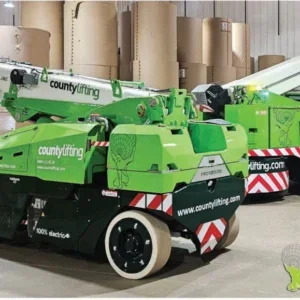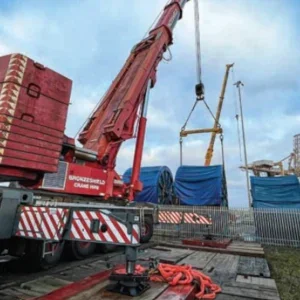Manufacturers use different ways to measure the performance of their cranes. While few companies are ever foolish enough to lie about the performance of their products, it is natural to want to stress the positive. Crane manufacturers try to present their products in the best possible light, choosing to headline with information that maximises the appeal of their cranes and not necessarily with the data that actually matters most to crane users.
But not only are the numbers chosen selectively, they may not have been arrived at in the way you had assumed. There is no international standard for preparing and presenting technical information. This leads to a situation where rival manufacturers put forward numbers which appear to be directly comparable. But if the numbers have not been calculated in the same way, comparisons are dangerous.
Because manufacturers use different methodology, product literature can indicate apparently large variations in performance figures, such as line pull for example, on similar sized machines. Anomalies can also be found when comparing load charts and in crane operation.
There are many points to consider when reading crane performance specification sheets.
Line pull
The line pull of a winch depends on the safe working load of the ropes. No matter what line pull figure is given in the literature, one can only use it in connection with the proper rope diameter and rope strength. On a lift crane look for the number of lines needed to lift the maximum load to arrive at what the single line pull in the outermost layer would be. Check the given cable diameter and verify that the minimum cable strength is five times the single line pull with rotation-resistant rope, and 3.5 times with regular rope.
The single line pull in the first layer will always be higher. Some manufacturers promote the line pull of the first layer, others are referring to the outermost layer. Therefore it is important to make sure that the numbers being compared actually refer to the same thing. In lift crane applications it is generally reckoned best to take the maximum pull on the outermost factory approved layer, as in the real world this is what the crane buyer is going to use when he rigs up the crane and the base parts of line for the hook block.
For duty-cycle operation (ie clam, dragline or grab work) the operation is normally done on the first layer – there is less rope wear, higher pull and rope synchronisation – but again in this case, the maximum usable pull is what the rope strength will allow and what the load chart will allow.
Check for winch diameter in relation to rope diameter. To assure long rope life, the winch diameter in relation to the first layer needs to be 21 times the rope diameter.
Check for the rope per layer. The fewer the layers, the longer the rope life.
One might also add on this point that both line speed and line pull are inversely proportional, no matter which layer you are looking at, ie increase the pull and your line speed will decrease, increase the line speed and your line pull will decrease (given the same horsepower engine). On a given size drum, the more layers of rope, the more spooling capacity there is (for a long boom for instance), but given the larger diameter (from more layers), you will need more power to maintain the same pull or speed as was available on the first layers – there is no free lunch.
Engine horsepower is important to be able to offer high speeds, especially when more than one motion is required at the same time. Check the oil flow rate of the winch pump and motor as well as the pressure. This gives the amount of horsepower the winch can develop. Use the following formula with hydraulic winches:
horsepower = gal/min x psi x 0.77
1714
where: gal/min = gallons per minute psi = pressure in lb/in2 1714 = factor to arrive at horsepower 0.77 = hydraulic efficiency between pump and winch drum
Based on that, you can interpret the speed at which a certain load can be lifted:
winch speed in (ft/min.) = horsepower on hook x 33000 line pull in lb
Maximum speed is limited by maximum rpm (min-1) of the hydraulic motor. Higher speeds can only be achieved with a gearbox. The generally accepted standard hydraulic pressure for constant operation of pumps, motors, hoses, etc. is 5,000psi. Anything above 6,000psi is only acceptable intermittently.
One should note that the engine requires a certain amount of power to drive all the pumps and gears as well as the cooling system. Therefore not all diesel engine horsepower is available at the winch. As a rule of thumb, whatever horsepower is required at the drum or on the hook, approximately 80% more horsepower needs to be available from the diesel engine. Small deviations may arise because of different design criteria of the hydraulic system, cooling circuit, etc.
Line pull might also be affected by using more than one motion at the same time. A high maximum swing speed, for example, which is only usable with a very short boom and is typical for duty-cycle applications, needs high torque swing motors. These need more power than lift crane applications where a special mode for precise inching is more important than maximum swing speeds.
Load charts When interpreting a load chart, one needs to know which standard was followed. Most European cranes use an ISO standard. This considers deratings for wind, 3% sideload, and 4° angle for the overall point of gravity (or 4.5° if travelling with load) under ISO standards. The crane must not tip even with 125% of maximum rated load plus 10% of the boom weight.
North America’s ANSI standards consider 75% of tipping (or 85% when on outriggers) and 2% side load. The different calculation methods result in considerable differences on the load chart.
Manufacturers have a certain degree of freedom about how they decide to construct their own load charts. In particular, some choose to include the weight of the wire rope in the charts, some choose not to. Given that the wire rope on a long luffing jib combination could weigh up to 1.8t (4,000lb), this could provide distinct variations in the load charts of cranes with identical capacities.
Similarly, some manufacturers prepare their luffing jib charts based on 1% gradients, while others use 0.5%. A chart which accounts for lifting on a 1% slope is always going to appear inferior to a chart which only accounts for slopes half as steep.
Ease of operation
Some cranes require the use of different levers for every motion, so that the operator cannot handle more than two at any one time. Joysticks with multiple operational modes allow more than two motions at the same time. For example: Left joystick: swing and winch I Right joystick: boom and winch II Foot pedals: travel in all directions So next time you are comparing specifications of cranes, be sure to ask the salesman how the data was arrived at. You might not always get the answer that you expected.






